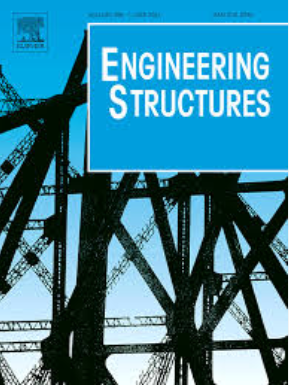用ECC或CFRP护套加固和修复非均匀腐蚀的RC柱:粘结性能评价
IF 5.6
1区 工程技术
Q1 ENGINEERING, CIVIL
引用次数: 0
摘要
本文研究了工程胶凝复合材料(ECC)和碳纤维增强聚合物(CFRP)护套修复非均匀腐蚀钢筋混凝土(RC)的粘结性能。虽然之前的研究探索了均匀腐蚀或未腐蚀构件的修复方法,但有限的研究考察了非均匀腐蚀和修复后二次腐蚀对粘结行为的影响。为了填补这一空白,采用一种新的辅助电极加速腐蚀方法对78个钢筋试件进行了非均匀腐蚀。修复策略包括在初始腐蚀阶段后应用ECC或CFRP护套,随后是第二阶段腐蚀阶段,以模拟修复后的持续恶化。这允许对修复后的耐久性和粘合性能进行现实的评估。通过拔出试验系统地评估了初始腐蚀速率、ECC修复厚度(10 mm vs. 15 mm)、CFRP约束和二次腐蚀持续时间的影响。结果表明:ECC修复将破坏模式由脆性断裂转变为延性拉拔,可使粘结强度提高44.04 %;CFRP护套粘结强度提高最高,达到70.35 %,但脆性破坏响应更强。值得注意的是,当使用10 mm层时,ecc修复试件的粘结强度随着腐蚀时间的延长而逐渐提高,而使用15 mm层时,其性能更稳定。该研究为钢筋混凝土(RC)结构腐蚀的实际情况提供了新的见解,并为选择和设计有效修复策略提供了定量指导。本文章由计算机程序翻译,如有差异,请以英文原文为准。
Strengthening and repair of non-uniformly corroded RC columns by ECC or CFRP jacketing: Bond performance evaluation
This study investigates the bond performance of non-uniformly corroded reinforced concrete (RC) repaired with either Engineered Cementitious Composites (ECC) or Carbon Fiber-Reinforced Polymer (CFRP) jacketing. While previous studies have explored repair methods for uniformly corroded or uncorroded members, limited research has examined the effects of non-uniform corrosion and post-repair secondary corrosion on bond behavior. To fill this gap, a novel auxiliary electrode-based accelerated corrosion method was used to induce non-uniform rebar corrosion in 78 specimens. The repair strategy involved applying ECC or CFRP jacketing after an initial corrosion stage, followed by a second-stage corrosion period to simulate continued deterioration after repair. This allows for a realistic evaluation of post-repair durability and bond performance. The influences of initial corrosion rate, ECC repair thickness (10 mm vs. 15 mm), CFRP confinement, and secondary corrosion duration were systematically evaluated through pull-out testing. The results show that ECC repair changed the failure mode from brittle splitting to ductile pull-out and improved bond strength by up to 44.04 %. CFRP jacketing achieved the highest bond strength increase of 70.35 %, although with a more brittle failure response. Notably, the bond strength in ECC-repaired specimens improved progressively with corrosion duration when using a 10 mm layer, while a 15 mm layer provided more stable performance. This study offers new insights into realistic corrosion scenarios and provides quantitative guidance for selecting and designing effective repair strategies for deteriorating reinforced concrete (RC) structures.
求助全文
通过发布文献求助,成功后即可免费获取论文全文。
去求助
来源期刊

Engineering Structures
工程技术-工程:土木
CiteScore
10.20
自引率
14.50%
发文量
1385
审稿时长
67 days
期刊介绍:
Engineering Structures provides a forum for a broad blend of scientific and technical papers to reflect the evolving needs of the structural engineering and structural mechanics communities. Particularly welcome are contributions dealing with applications of structural engineering and mechanics principles in all areas of technology. The journal aspires to a broad and integrated coverage of the effects of dynamic loadings and of the modelling techniques whereby the structural response to these loadings may be computed.
The scope of Engineering Structures encompasses, but is not restricted to, the following areas: infrastructure engineering; earthquake engineering; structure-fluid-soil interaction; wind engineering; fire engineering; blast engineering; structural reliability/stability; life assessment/integrity; structural health monitoring; multi-hazard engineering; structural dynamics; optimization; expert systems; experimental modelling; performance-based design; multiscale analysis; value engineering.
Topics of interest include: tall buildings; innovative structures; environmentally responsive structures; bridges; stadiums; commercial and public buildings; transmission towers; television and telecommunication masts; foldable structures; cooling towers; plates and shells; suspension structures; protective structures; smart structures; nuclear reactors; dams; pressure vessels; pipelines; tunnels.
Engineering Structures also publishes review articles, short communications and discussions, book reviews, and a diary on international events related to any aspect of structural engineering.
 求助内容:
求助内容: 应助结果提醒方式:
应助结果提醒方式:


